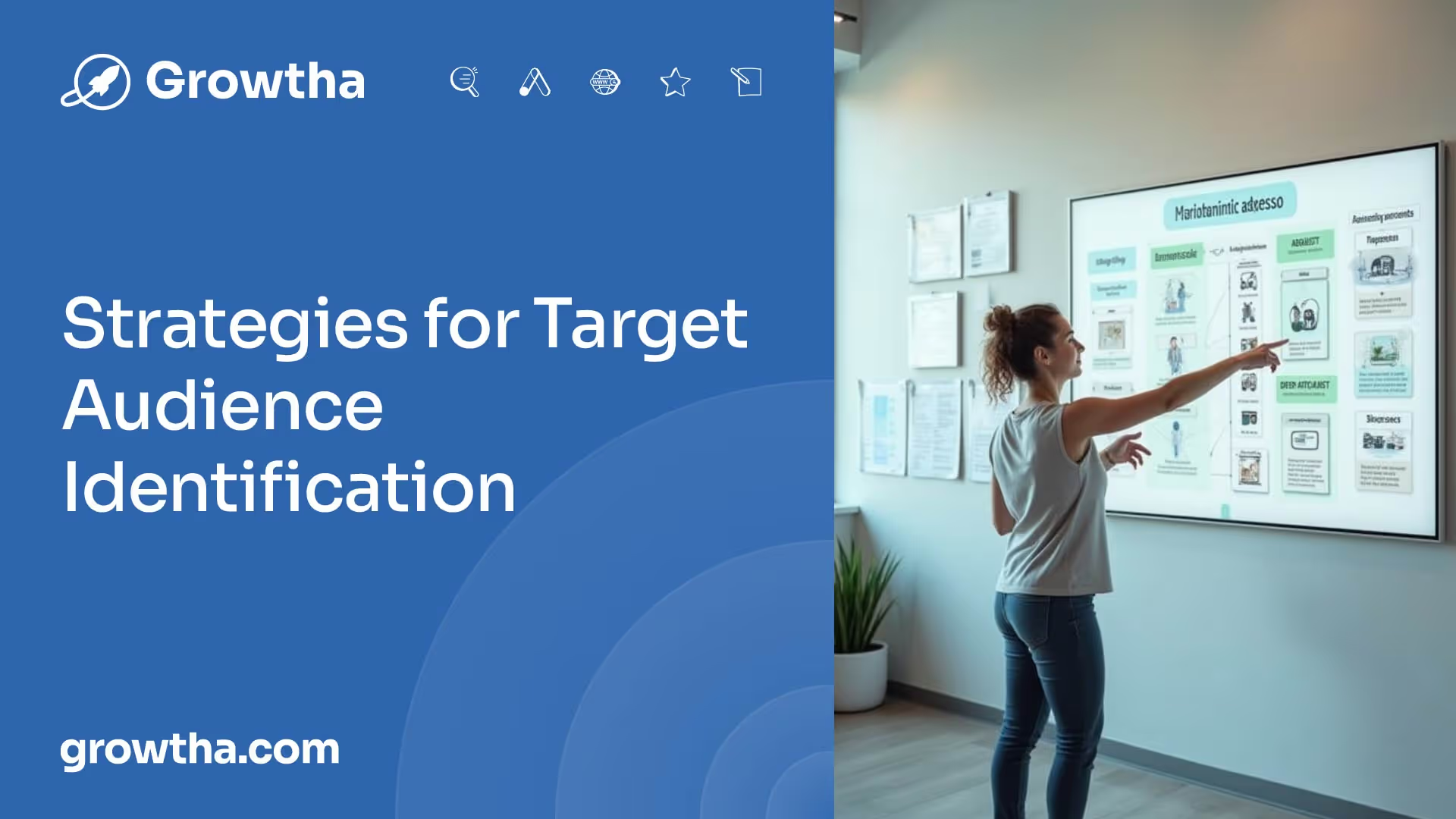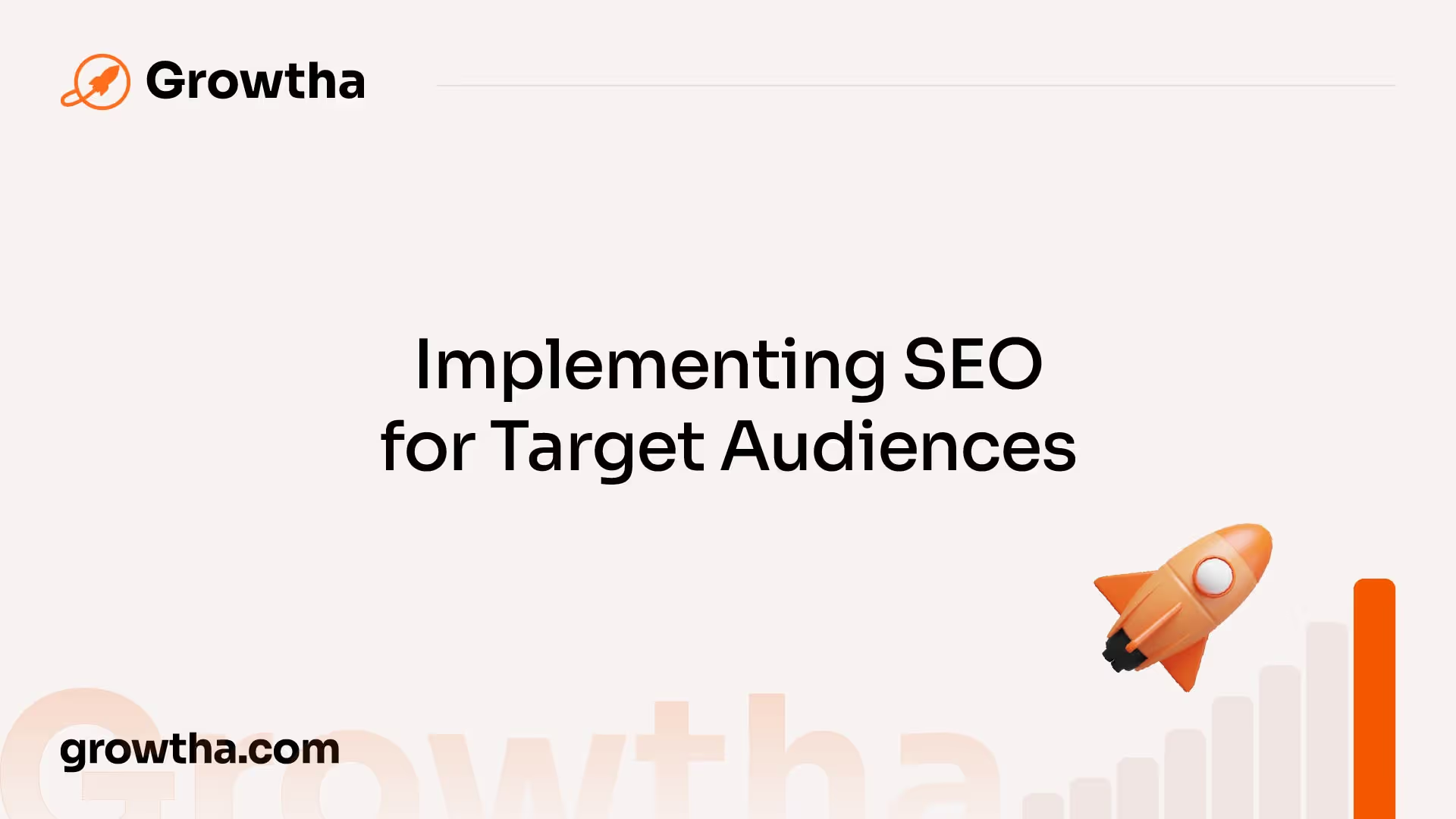How to Define Your Target Audience for SEO
By recognizing the characteristics and needs of your audience, you can tailor your SEO strategies to effectively reach and engage them.


How to Define Your Target Audience for SEO
Understanding Target Audiences
In the world of SEO, understanding and identifying your target audience is of utmost importance. By recognizing the characteristics and needs of your audience, you can tailor your SEO strategies to effectively reach and engage them.
Importance of Identifying Target Audience
Identifying your target audience is crucial for several reasons. Firstly, it allows businesses to distinguish between different types of audiences and identify specific consumer segments that support their product or service. This understanding leads to repeat purchases and customer loyalty [1].
Secondly, defining a target audience improves marketing efforts by providing clarity in developing effective marketing strategies. By understanding the demographics, interests, and behaviors of the audience, businesses can create compelling and relevant content that resonates with their target market.
Lastly, identifying the target audience enables businesses to allocate marketing resources effectively. By evaluating which audience segments are most likely to purchase their product or service, businesses can prioritize their marketing efforts and prevent wastage of resources [1].
Benefits of Defining Target Audience
Defining your target audience brings numerous benefits to your SEO strategy. Some of the key advantages are:
- Attracting High-Quality Visitors: When you know your target audience, you can create content and optimize your website to attract high-quality and targeted visitors who are genuinely interested in your products or services. This helps in driving traffic that is more likely to convert into leads or customers.
- Tailored Content: Understanding your target audience allows you to create tailored content that meets their specific needs and interests. By addressing their pain points and providing relevant information, you can build trust and establish your authority in the industry. This leads to increased engagement and a higher likelihood of conversions.
- Improved Search Results: Knowing your target audience helps you understand how they interact with your website and search for information. This knowledge allows you to optimize your website content to reflect their queries and improve search results. By aligning your content with their search intent, you increase the chances of ranking higher in search engine results pages [3].
- Enhanced User Experience: When you have a clear understanding of your target audience, you can optimize your website's user experience to cater to their preferences. By providing a seamless and intuitive browsing experience, you can keep visitors engaged and encourage them to explore more of your website. This can lead to higher conversion rates and improved customer satisfaction.
By recognizing the importance of identifying your target audience and reaping the benefits of defining them, you can shape your SEO strategies to effectively reach, engage, and convert your desired audience.

Target Audience Research Methods
To effectively understand and reach your target audience, it's essential to employ various research methods. These methods provide valuable insights into the demographics, preferences, and behaviors of your audience. Two key research methods for identifying your target audience are market research and SWOT analysis, as well as utilizing Google Analytics insights.
Market Research and SWOT Analysis
Market research, including SWOT analysis, plays a crucial role in identifying your target audience effectively. Conducting market research helps you gain insights into the location, demographics, psychographics, market trends, and customer buying habits. SWOT analysis, on the other hand, evaluates the strengths, weaknesses, opportunities, and threats of your business, enabling you to identify the unique selling points and areas for improvement.
Market research involves gathering data through surveys, interviews, focus groups, and analyzing existing data sources. By understanding your target audience's needs, pain points, and desires, you can tailor your marketing strategies to address their specific requirements. This research helps you create targeted content, choose appropriate channels, and refine your messaging for maximum impact.
Utilizing Google Analytics Insights
Google Analytics provides a wealth of data about your website visitors, offering valuable insights into your target audience. By utilizing Google Analytics, you can gather information on demographics, behavior, interests, and more [1]. This data helps you understand your audience's preferences, the pages they visit, and the actions they take on your website.
Through Google Analytics, you can identify key metrics such as age, gender, location, and interests of your website visitors. This information allows you to create targeted content and optimize your website to better cater to the needs and interests of your target audience. Additionally, Google Analytics provides data on user engagement, bounce rates, and conversion rates, enabling you to measure the effectiveness of your marketing efforts and make data-driven decisions.
By combining market research, SWOT analysis, and Google Analytics insights, you can gain a comprehensive understanding of your target audience. This knowledge empowers you to develop effective marketing strategies, tailor your content to their preferences, and deliver a personalized experience that resonates with your audience. Continuously monitoring and analyzing this data will help you stay connected to your target audience and adapt your strategies as their preferences evolve.

Strategies for Target Audience Identification
To effectively implement SEO strategies, it is essential to identify and understand your target audience. By knowing your audience, you can tailor your content and optimization efforts to meet their needs and preferences. Here are two effective strategies for target audience identification: audience surveys and social media analysis, as well as leveraging competitor research.
Audience Surveys and Social Media Analysis
Conducting audience surveys can provide valuable insights into your target audience's experiences, desires, and preferences. Surveys help gather information about their needs, challenges, and expectations, allowing you to tailor your content and optimization strategies accordingly. By leveraging platforms like Audiense, you can analyze social media audience data to gain deeper insights into your target audience's interests, behaviors, and demographics.
By combining the data gathered from surveys and social media analysis, you can uncover content gaps, collect keyword ideas, and better understand the specific areas of interest that resonate with your target audience. This knowledge enables you to create highly relevant and valuable content that addresses their pain points and engages them effectively.
Leveraging Competitor Research
Analyzing your competitors can provide valuable insights into your target audience. By reviewing how your competitors engage with users and analyzing data from various marketing channels, you can gain a better understanding of the demographics, interests, and behaviors of your target audience. Tools like Quantcast and Audiense can help you gather information on purchase behaviors, demographics, interests, and more, providing valuable data for content topic recommendations and link building ideas [4].
By studying and analyzing competitors' strategies and audience engagement, you can identify gaps in the market and tailor your SEO efforts to stand out from the competition. This research can also help you discover new opportunities to engage with your target audience and provide content that meets their specific needs.
By combining audience surveys and social media analysis with competitor research, you can build comprehensive customer personas based on data collected about your audience. These personas can help you personalize your content and messaging for different segments of your target audience, enabling you to create highly targeted and engaging content that resonates with your audience.
Identifying and understanding your target audience is a crucial step in implementing effective SEO strategies. By utilizing audience surveys, social media analysis, and competitor research, you can gain valuable insights that will inform your content optimization efforts and help you connect with your target audience in a meaningful way.

Implementing SEO for Target Audiences
Once you have identified your target audience, it's important to implement SEO strategies that effectively reach and engage them. Two key areas to focus on are content optimization strategies and keyword research and targeting tactics.
Content Optimization Strategies
Content optimization plays a vital role in reaching and resonating with your target audience. By crafting high-quality, relevant, and valuable content, you can improve your website's visibility and attract organic traffic. Some content optimization strategies to consider include:
- Understanding User Intent: Analyze the search intent behind the keywords your target audience is using. Are they looking for information, solutions, or products? By understanding their intent, you can tailor your content to provide the most relevant and helpful information.
- Creating Engaging Content: Develop content that captivates your target audience. Use a mix of formats such as articles, videos, infographics, and podcasts to cater to different preferences. Incorporate storytelling techniques, visuals, and interactive elements to make your content more engaging and shareable.
- Optimizing On-Page Elements: Pay attention to on-page elements like titles, headings, meta descriptions, and URLs. Optimize these elements by incorporating relevant keywords, using clear and concise language, and enticing users to click through to your content.
- Enhancing Readability: Structure your content in a logical and easy-to-read format. Use headings, subheadings, bullet points, and short paragraphs to improve readability. Break down complex concepts into digestible pieces, avoiding jargon or technical terms that may confuse your audience.

Keyword Research and Targeting Tactics
Keyword research is a fundamental aspect of SEO. It helps you understand the language and phrases your target audience uses when searching for information. By identifying and targeting the right keywords, you can improve your website's visibility in search engine results and drive relevant traffic. Consider the following tactics for effective keyword research and targeting:
- Identify Relevant Keywords: Start by brainstorming a list of keywords that are relevant to your industry, products, or services. Use tools like Google Keyword Planner, SEMrush, or Moz Keyword Explorer to discover additional keywords and evaluate their search volume and competition.
- Analyze User Intent: As mentioned earlier, understanding the intent behind the keywords is crucial. Are users looking for information, trying to make a purchase, or seeking solutions to a specific problem? Tailor your content to align with their intent, whether it's informational, transactional, or navigational.
- Consider Long-Tail Keywords: Long-tail keywords are more specific and have lower search volume but often demonstrate higher intent and conversion rates. Incorporate long-tail keywords into your content to capture highly targeted traffic and address the specific needs of your audience.
- Monitor and Adapt: Regularly review and update your keyword strategy to stay aligned with evolving user behavior and changing search patterns. Keep an eye on industry trends, popular topics, and emerging keywords to ensure your content remains fresh and relevant.
Keyword research not only helps you identify individual keywords but also reveals clusters of topics and themes that your target audience is interested in. This valuable information can guide your content calendar and broader content strategy, ensuring you provide the most relevant and engaging content to your audience.
By implementing these content optimization strategies and conducting thorough keyword research and targeting, you can optimize your website to effectively reach and engage your target audience. Remember to regularly analyze and adapt your SEO tactics to stay ahead of the competition and meet the evolving needs of your audience.

Enhancing Website for Target Audience
Once you have identified your target audience, it's crucial to enhance your website to cater to their needs and improve their overall experience. Effective on-page and off-page SEO techniques play a significant role in optimizing your website and attracting the right audience.
On-Page SEO Techniques
On-page SEO techniques focus on optimizing the elements within your website to improve its visibility in search engine results. Here are some key strategies to consider:
- Keyword Research and Targeting: Conduct thorough keyword research to understand the search behavior of your target audience. Identify relevant keywords and incorporate them strategically within your website's content, titles, headings, and meta tags. Utilize a mix of head terms and long-tail terms to strike a balance between short-term wins and long-term goals in SEO [6].
- Optimized Content: Create high-quality, informative, and engaging content that aligns with the interests and needs of your target audience. Ensure that your content is well-structured, easy to read, and optimized with relevant keywords. Incorporate headings, subheadings, bullet points, and lists to enhance readability and user experience.
- Schema.org Markup: Implementing Schema.org markup helps search engines understand the content on your website better. It allows you to provide structured data about your products, services, reviews, and more. This can enhance your search engine visibility and improve the chances of appearing in rich snippets in search results [7].
- Mobile Optimization: With the increasing use of mobile devices, optimizing your website for mobile is crucial. Ensure that your website is responsive, loads quickly, and provides a seamless experience across different screen sizes. Mobile optimization is not only important for user experience but also a ranking factor in search engine algorithms.
Off-Page Optimization and Link Building
Off-page SEO techniques focus on improving your website's visibility and credibility through external factors. Here are some key strategies to consider:
- Link Building: Building high-quality, relevant, and authoritative backlinks to your website is an essential aspect of off-page optimization. Seek opportunities to collaborate with other websites, industry influencers, and publications to earn backlinks. This can help drive traffic to your website and improve its ranking in major search engines.
- Blogging and Content Marketing: Create valuable and shareable content, such as blog posts, articles, infographics, and white papers, to establish your website as a reliable source of information. Promote your content through social media channels and engage with your target audience. Encouraging social sharing can help increase visibility and attract relevant traffic to your website.
- Social Networks: Leverage social media platforms to connect with your target audience, share your content, and engage in conversations. Building a strong social media presence can help increase brand awareness, drive traffic to your website, and improve your website's authority and credibility.
Remember, search engines use complex algorithms to determine the value and relevance of your website. By implementing a combination of on-page and off-page optimization techniques, you can enhance your website's visibility, attract the right audience, and improve your SEO ranking. Continuously monitor and analyze the performance of your website to make necessary adjustments and stay ahead of the competition.
Advanced SEO Techniques
As the field of SEO evolves, it's important to stay ahead of the game and utilize advanced techniques to optimize your website for your target audience. In this section, we will explore two advanced SEO techniques: local SEO optimization and mobile SEO with AMP implementation.
Local SEO Optimization
Local SEO optimization focuses on optimizing websites and content to appear in regional search results. This technique is particularly beneficial for businesses serving local markets, such as restaurants, retail stores, auto repair shops, or plumbers. By implementing local SEO strategies, businesses can increase their visibility to potential customers in their specific geographic area.
One of the key components of local SEO optimization is optimizing your website's on-page elements to target local keywords and phrases. This includes incorporating location-specific keywords in your page titles, meta descriptions, headings, and content. Additionally, it's essential to create location-specific landing pages that provide valuable information about your business and its offerings in the targeted region.
Another critical aspect of local SEO optimization is ensuring consistent and accurate information across various online directories and platforms. This includes claiming and optimizing your Google My Business listing, as well as listing your business in local directories. Consistency in your business name, address, and phone number (NAP) information is vital for improving your local search rankings.
Mobile SEO and AMP Implementation
With the increasing use of mobile devices for internet browsing, mobile SEO has become an essential aspect of website optimization. Mobile SEO goes beyond ensuring a mobile-friendly design and focuses on providing a seamless user experience across various mobile devices.
Google emphasizes consistent content display on both desktop and mobile devices. To achieve this, it is crucial to optimize your website for mobile loading speed and performance. Slow-loading mobile pages can lead to a poor user experience and negatively impact your search rankings. Implementing Accelerated Mobile Pages (AMP) can help improve mobile page loading times, resulting in a better user experience and potentially higher search rankings [9].
When implementing mobile SEO, consider factors such as responsive design, mobile-friendly navigation, and optimized images. Ensure that your website is easily navigable on smaller screens and that the content is legible without requiring users to zoom in.
By leveraging local SEO optimization and focusing on mobile SEO with AMP implementation, you can enhance your website's visibility, reach, and user experience. These advanced techniques allow you to cater to the specific needs and preferences of your target audience, ultimately driving more traffic to your website and increasing your chances of success in the competitive online landscape.
References
[1]: https://www.incrementors.com/blog/importance-of-target-audience/
[2]: https://resources.audiense.com/en/blog/methods-to-define-your-target-audience-for-seo
[3]: https://resultsrepeat.com/know-your-target-audience-seo/
[4]: https://www.searchenginejournal.com/methods-research-analyze-audience/306487/
[5]: https://databox.com/how-to-identify-the-target-audience-for-your-website
[6]: https://blog.hubspot.com/marketing/how-to-do-keyword-research-ht







